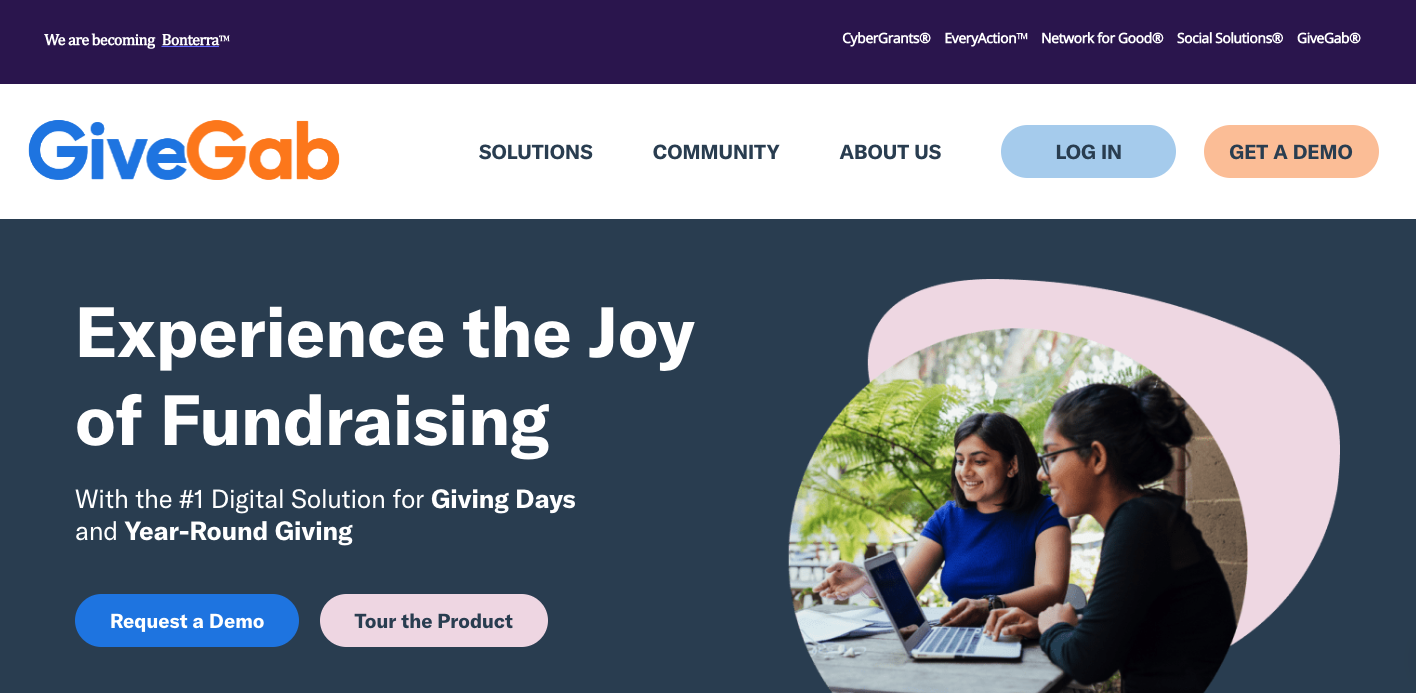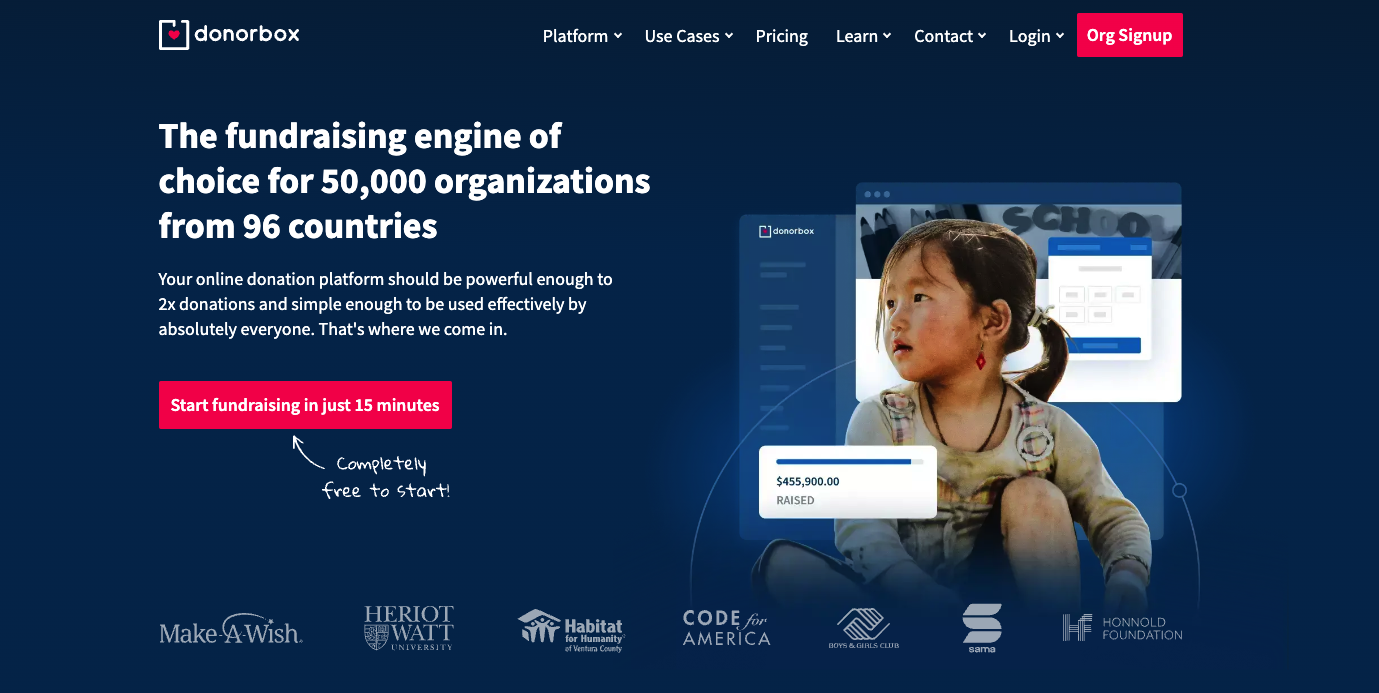SEO
5 Alternatives To AmazonSmile For Integrated Charity Donations

AmazonSmile has been sunset by Amazon, leaving a gap for non-profits that could collect donations from Amazon shoppers without charge.
Non-profit leaders are now looking for new platforms and venues to continue their low-overhead fundraising efforts in the wake of this decision.
To help them maintain their minor donations without the hassle of time and money spent in arduous fundraising conversations, we created a list of alternative integrated charity donation platforms.
We’ve compared AmazonSmile’s popular process and features – and compiled both positive and negative feedback from non-profits on the news.
What Is AmazonSmile?
Amazon discontinued its well-known charitable initiative, AmazonSmile, as of February 23, 2023.
The integrated charitable giving platform enabled non-profit organizations to accept donations from everyday Amazon shoppers at no extra cost or direct engagement.
The program has earned more than $400 million for non-profit partners in the U.S. alone and more than $449 million globally since its launch in 2013.
Through the marketplace giant’s charitable giving platform, Amazon customers could donate 0.5% of their purchase price through AmazonSmile to various non-profit organizations.
Through the AmazonSmile Foundation, the donations are automatically sent to the non-profit organization’s account in a relatively painless payout process.
For both customers and non-profit organizations, using the program is free, making it a desirable choice for anyone seeking to collect money without racking up overhead expenses.
Non-profit groups were pleased with the program because it gave them a simple way to earn money and let them concentrate on their mission without worrying about how to fund it (at least in part).
Although AmazonSmile was easy to use and had barely any overhead costs, non-profit groups had some reservations regarding the quantity of money being donated.
The 0.5% donation rate was negligible; many charities felt they weren’t getting enough money to have a meaningful impact.
Furthermore, non-profit organizations may only receive money through certain channels, such as bank transfers, which can take several weeks to process and make allocating funds a hurdle for some organizations.
Regardless of these issues, non-profit groups (large and small) continued to use AmazonSmile as a popular platform and a reliable source of funding.
After Amazon’s public statement online and in the news announcing the sunset of AmazonSmile due to leadership’s concerns about the platform’s low impact, many wonder if the tech industry’s recent volatility and Amazon’s budget cuts are involved.
Regardless, non-profit leaders are on the lookout for the next best alternative.
What Are The Best Alternative Charity Donation Platforms?
Fortunately, non-profit organizations have access to numerous additional integrated platforms for charitable donations.
They’ll likely require more setup and configuration than AmazonSmile, but they also provide much more control and customization that non-profits can use to their advantage.
My list of the best current options out there is provided below:
1. Benevity
Benevity is a top platform for corporate social responsibility, giving businesses and non-profit groups a tool to oversee and monitor their social impact.
It provides several services, such as campaign donating, volunteer management, and donation matching.
The website also allows non-profit groups to set up fundraising campaigns and receive donations directly into their accounts.
The platform is a desirable alternative for non-profit groups wishing to connect with corporations because it includes various corporate partners, such as Google, Microsoft, and Target.
Benevity offers customized pricing plans based on the needs and size of the non-profit organization.
2. GiveGab
 Screenshot from GiveGab, March 2023
Screenshot from GiveGab, March 2023GiveGab is a one-stop platform for fundraising that provides non-profit organizations with various tools to design and administer fundraising campaigns.
Some of the functions it offers include peer-to-peer fundraising, event administration, and volunteer management.
To assist non-profit organizations in tracking their success and making fact-based decisions, GiveGab also offers a range of fundraising analytics and reporting tools.
With a 2% transaction fee for donations, the monthly price is zero dollars.
3. Donorbox
 Screenshot from Donorbox, March 2023
Screenshot from Donorbox, March 2023A user-friendly platform for donations called Donorbox enables non-profit organizations to design bespoke donation forms and collect recurring payments.
With the platform’s integration with well-known payment processors like PayPal and Stripe, receiving money is simple and rapid.
Moreover, Donorbox provides several services, such as donor management, data analysis, and integrations with well-known CRM systems like Salesforce.
For non-profit organizations, the pricing starts at 1.5% per transaction, making it an affordable option.
4. RallyUp
 Screenshot from RallyUp, March 2023
Screenshot from RallyUp, March 2023With the help of the fundraising platform RallyUp, non-profit groups can design and control a variety of fundraising initiatives, such as raffles, auctions, and crowdfunding.
It also provides social media connectors, editable donation pages, and progress tracking for fundraising campaigns.
The pricing structure of RallyUp is simple, with no setup fees, no monthly fees, and a flat processing fee of 4.9% on donations.
Because of this, non-profit groups looking for a flexible, affordable fundraising platform may find RallyUp to be an appealing choice.
5. JustGiving
 Screenshot from JustGiving, March 2023
Screenshot from JustGiving, March 2023A fundraising tool called JustGiving, which is based in the U.K., enables non-profit groups to design unique donation pages, keep track of payments, and receive money straight into their accounts.
Several services are available on the site, such as team fundraising, event management, and integrations with well-known CRM systems.
With over 22 million registered members globally, JustGiving has a sizable user base and is a fantastic choice for non-profit organizations trying to reach a global audience.
While there is no information on pricing on its website as of March 2023, JustGiving provides pricing estimates upon request.
How Should Non-Profits Move Away From AmazonSmile?
Many thought leaders in the non-profit sector interpret the news as a signal to reprioritize the development of their organization’s mission, vision, and values in an effort to attract major donations.
While this is incredibly important for any brand to prioritize, it takes time. And if there’s anything non-profit leaders don’t have, it’s time.
In conclusion, there are many other accessible, integrated charity donation platforms, even though AmazonSmile’s demise may be distressing for non-profit organizations that have grown dependent on the platform.
Despite the inconvenience, it’s crucial for non-profit organizations to carefully consider which platform best suits their needs because each of the platforms we’ve covered offers special features, pricing structures, and areas of specialization.
More Resources:
Featured Image: Ground Picture/Shutterstock
SEO
Google Rolls Out New ‘Web’ Filter For Search Results

Google is introducing a filter that allows you to view only text-based webpages in search results.
The “Web” filter, rolling out globally over the next two days, addresses demand from searchers who prefer a stripped-down, simplified view of search results.
Danny Sullivan, Google’s Search Liaison, states in an announcement:
“We’ve added this after hearing from some that there are times when they’d prefer to just see links to web pages in their search results, such as if they’re looking for longer-form text documents, using a device with limited internet access, or those who just prefer text-based results shown separately from search features.”
We’ve added this after hearing from some that there are times when they’d prefer to just see links to web pages in their search results, such as if they’re looking for longer-form text documents, using a device with limited internet access, or those who just prefer text-based…
— Google SearchLiaison (@searchliaison) May 14, 2024
The new functionality is a throwback to when search results were more straightforward. Now, they often combine rich media like images, videos, and shopping ads alongside the traditional list of web links.
How It Works
On mobile devices, the “Web” filter will be displayed alongside other filter options like “Images” and “News.”
If Google’s systems don’t automatically surface it based on the search query, desktop users may need to select “More” to access it.
 Screenshot from: twitter.com/GoogleSearchLiaison, May 2024.
Screenshot from: twitter.com/GoogleSearchLiaison, May 2024.More About Google Search Filters
Google’s search filters allow you to narrow results by type. The options displayed are dynamically generated based on your search query and what Google’s systems determine could be most relevant.
The “All Filters” option provides access to filters that are not shown automatically.
Alongside filters, Google also displays “Topics” – suggested related terms that can further refine or expand a user’s original query into new areas of exploration.
For more about Google’s search filters, see its official help page.
Featured Image: egaranugrah/Shutterstock
SEO
Why Google Can’t Tell You About Every Ranking Drop

In a recent Twitter exchange, Google’s Search Liaison, Danny Sullivan, provided insight into how the search engine handles algorithmic spam actions and ranking drops.
The discussion was sparked by a website owner’s complaint about a significant traffic loss and the inability to request a manual review.
Sullivan clarified that a site could be affected by an algorithmic spam action or simply not ranking well due to other factors.
He emphasized that many sites experiencing ranking drops mistakenly attribute it to an algorithmic spam action when that may not be the case.
“I’ve looked at many sites where people have complained about losing rankings and decide they have a algorithmic spam action against them, but they don’t. “
Sullivan’s full statement will help you understand Google’s transparency challenges.
Additionally, he explains why the desire for manual review to override automated rankings may be misguided.
Two different things. A site could have an algorithmic spam action. A site could be not ranking well because other systems that *are not about spam* just don’t see it as helpful.
I’ve looked at many sites where people have complained about losing rankings and decide they have a…
— Google SearchLiaison (@searchliaison) May 13, 2024
Challenges In Transparency & Manual Intervention
Sullivan acknowledged the idea of providing more transparency in Search Console, potentially notifying site owners of algorithmic actions similar to manual actions.
However, he highlighted two key challenges:
- Revealing algorithmic spam indicators could allow bad actors to game the system.
- Algorithmic actions are not site-specific and cannot be manually lifted.
Sullivan expressed sympathy for the frustration of not knowing the cause of a traffic drop and the inability to communicate with someone about it.
However, he cautioned against the desire for a manual intervention to override the automated systems’ rankings.
Sullivan states:
“…you don’t really want to think “Oh, I just wish I had a manual action, that would be so much easier.” You really don’t want your individual site coming the attention of our spam analysts. First, it’s not like manual actions are somehow instantly processed. Second, it’s just something we know about a site going forward, especially if it says it has change but hasn’t really.”
Determining Content Helpfulness & Reliability
Moving beyond spam, Sullivan discussed various systems that assess the helpfulness, usefulness, and reliability of individual content and sites.
He acknowledged that these systems are imperfect and some high-quality sites may not be recognized as well as they should be.
“Some of them ranking really well. But they’ve moved down a bit in small positions enough that the traffic drop is notable. They assume they have fundamental issues but don’t, really — which is why we added a whole section about this to our debugging traffic drops page.”
Sullivan revealed ongoing discussions about providing more indicators in Search Console to help creators understand their content’s performance.
“Another thing I’ve been discussing, and I’m not alone in this, is could we do more in Search Console to show some of these indicators. This is all challenging similar to all the stuff I said about spam, about how not wanting to let the systems get gamed, and also how there’s then no button we would push that’s like “actually more useful than our automated systems think — rank it better!” But maybe there’s a way we can find to share more, in a way that helps everyone and coupled with better guidance, would help creators.”
Advocacy For Small Publishers & Positive Progress
In response to a suggestion from Brandon Saltalamacchia, founder of RetroDodo, about manually reviewing “good” sites and providing guidance, Sullivan shared his thoughts on potential solutions.
He mentioned exploring ideas such as self-declaration through structured data for small publishers and learning from that information to make positive changes.
“I have some thoughts I’ve been exploring and proposing on what we might do with small publishers and self-declaring with structured data and how we might learn from that and use that in various ways. Which is getting way ahead of myself and the usual no promises but yes, I think and hope for ways to move ahead more positively.”
Sullivan said he can’t make promises or implement changes overnight, but he expressed hope for finding ways to move forward positively.
Featured Image: Tero Vesalainen/Shutterstock
SEO
56 Google Search Statistics to Bookmark for 2024

If you’re curious about the state of Google search in 2024, look no further.
Each year we pick, vet, and categorize a list of up-to-date statistics to give you insights from trusted sources on Google search trends.
- Google has a web index of “about 400 billion documents”. (The Capitol Forum)
- Google’s search index is over 100 million gigabytes in size. (Google)
- There are an estimated 3.5 billion searches on Google each day. (Internet Live Stats)
- 61.5% of desktop searches and 34.4% of mobile searches result in no clicks. (SparkToro)
- 15% of all Google searches have never been searched before. (Google)
- 94.74% of keywords get 10 monthly searches or fewer. (Ahrefs)
- The most searched keyword in the US and globally is “YouTube,” and youtube.com gets the most traffic from Google. (Ahrefs)
- 96.55% of all pages get zero search traffic from Google. (Ahrefs)
- 50-65% of all number-one spots are dominated by featured snippets. (Authority Hacker)
- Reddit is the most popular domain for product review queries. (Detailed)
- Google is the most used search engine in the world, with a mobile market share of 95.32% and a desktop market share of 81.95%. (Statista)


- Google.com generated 84.2 billion visits a month in 2023. (Statista)
- Google generated $307.4 billion in revenue in 2023. (Alphabet Investor Relations)
- 63.41% of all US web traffic referrals come from Google. (SparkToro)
- 92.96% of global traffic comes from Google Search, Google Images, and Google Maps. (SparkToro)
- Only 49% of Gen Z women use Google as their search engine. The rest use TikTok. (Search Engine Land)
- 58.67% of all website traffic worldwide comes from mobile phones. (Statista)
- 57% of local search queries are submitted using a mobile device or tablet. (ReviewTrackers)


- 51% of smartphone users have discovered a new company or product when conducting a search on their smartphones. (Think With Google)
- 54% of smartphone users search for business hours, and 53% search for directions to local stores. (Think With Google)
- 18% of local searches on smartphones lead to a purchase within a day vs. 7% of non-local searches. (Think With Google)
- 56% of in-store shoppers used their smartphones to shop or research items while they were in-store. (Think With Google)
- 60% of smartphone users have contacted a business directly using the search results (e.g., “click to call” option). (Think With Google)
- 63.6% of consumers say they are likely to check reviews on Google before visiting a business location. (ReviewTrackers)
- 88% of consumers would use a business that replies to all of its reviews. (BrightLocal)
- Customers are 2.7 times more likely to consider a business reputable if they find a complete Business Profile on Google Search and Maps. (Google)
- Customers are 70% more likely to visit and 50% more likely to consider purchasing from businesses with a complete Business Profile. (Google)
- 76% of people who search on their smartphones for something nearby visit a business within a day. (Think With Google)
- 28% of searches for something nearby result in a purchase. (Think With Google)
- Mobile searches for “store open near me” (such as, “grocery store open near me” have grown by over 250% in the last two years. (Think With Google)
- People use Google Lens for 12 billion visual searches a month. (Google)
- 50% of online shoppers say images helped them decide what to buy. (Think With Google)
- There are an estimated 136 billion indexed images on Google Image Search. (Photutorial)
- 15.8% of Google SERPs show images. (Moz)
- People click on 3D images almost 50% more than static ones. (Google)
- More than 800 million people use Google Discover monthly to stay updated on their interests. (Google)
- 46% of Google Discover URLs are news sites, 44% e-commerce, 7% entertainment, and 2% travel. (Search Engine Journal)
- Even though news sites accounted for under 50% of Google Discover URLs, they received 99% of Discover clicks. (Search Engine Journal)


- Most Google Discover URLs only receive traffic for three to four days, with most of that traffic occurring one to two days after publishing. (Search Engine Journal)
- The clickthrough rate (CTR) for Google Discover is 11%. (Search Engine Journal)
- 91.45% of search volumes in Google Ads Keyword Planner are overestimates. (Ahrefs)
- For every $1 a business spends on Google Ads, they receive $8 in profit through Google Search and Ads. (Google)
- Google removed 5.5 billion ads, suspended 12.7 million advertiser accounts, restricted over 6.9 billion ads, and restricted ads from showing up on 2.1 billion publisher pages in 2023. (Google)
- The average shopping click-through rate (CTR) across all industries is 0.86% for Google Ads. (Wordstream)
- The average shopping cost per click (CPC) across all industries is $0.66 for Google Ads. (Wordstream)
- The average shopping conversion rate (CVR) across all industries is 1.91% for Google Ads. (Wordstream)
- 58% of consumers ages 25-34 use voice search daily. (UpCity)
- 16% of people use voice search for local “near me” searches. (UpCity)
- 67% of consumers say they’re very likely to use voice search when seeking information. (UpCity)
- Active users of the Google Assistant grew 4X over the past year, as of 2019. (Think With Google)
- Google Assistant hit 1 billion app installs. (Android Police)
- AI-generated answers from SGE were available for 91% of entertainment queries but only 17% of healthcare queries. (Statista)
- The AI-generated answers in Google’s Search Generative Experience (SGE) do not match any links from the top 10 Google organic search results 93.8% of the time. (Search Engine Journal)
- Google displays a Search Generative element for 86.8% of all search queries. (Authoritas)


- 62% of generative links came from sources outside the top 10 ranking organic domains. Only 20.1% of generative URLs directly match an organic URL ranking on page one. (Authoritas)
- 70% of SEOs said that they were worried about the impact of SGE on organic search (Aira)
Learn more
Check out more resources on how Google works:
-

 SEO6 days ago
SEO6 days agoHow to Use Keywords for SEO: The Complete Beginner’s Guide
-

 MARKETING7 days ago
MARKETING7 days agoHow To Protect Your People and Brand
-

 MARKETING4 days ago
MARKETING4 days agoAdvertising on Hulu: Ad Formats, Examples & Tips
-

 MARKETING5 days ago
MARKETING5 days agoUpdates to data build service for better developer experiences
-

 MARKETING2 days ago
MARKETING2 days ago18 Events and Conferences for Black Entrepreneurs in 2024
-

 MARKETING6 days ago
MARKETING6 days agoThe Ultimate Guide to Email Marketing
-

 WORDPRESS4 days ago
WORDPRESS4 days agoBest WordPress Plugins of All Time: Updated List for 2024
-

 PPC6 days ago
PPC6 days agoGoogle Shopping: A Beginner’s Guide to Crafting a Compelling Campaign Google Shopping: A Beginner’s Guide to Crafting a Compelling Campaign















